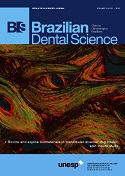Tooth abnormalities in pediatric patients submitted to antineoplastic treatment for central nervous system neoplasms
DOI:
https://doi.org/10.14295/bds.2016.v19i3.1263Resumo
Objective: The aim of this study was to evaluate the frequency of tooth abnormalities in pediatric patients treated for central nervous system neoplasms. Material and methods: This cross-sectional study assessed thirty-one patients, median age 14.2 years (range 5 - 25), who were off therapy for at least one year, comparatively with a control group of thirty-one healthy patients matched for age with the study group. Tooth abnormalities were evaluated by panoramic radiographs. Results: There was no statistical significant evidence that patients of the study group (age range 5 - 25 years) have more frequency of tooth abnormalities comparatively with controls. However, in children who were diagnosed before 5 years of age, microdontia was the most common abnormality with statistically significant difference (P=0.037). Root shortening grade III was observed in patients over 10 years of age at the time of radiographic examination, also with statistical significance (P=0.046). Conclusions: Tooth abnormalities frequency in patients treated for central nervous system neoplasms is directly related to the age of diagnosis and stage of odontogenesis. Microdontia and reduced root surface areas, the most common abnormalities observed, can lead to future oral health impairment due to malocclusion and less periodontal support. It is important to give parents and patients early orientation about maintenance of good oral hygiene and proper treatment by orthodontics or dentofacial orthopedics.Downloads
Downloads
Publicado
Como Citar
Edição
Seção
Licença
TRANSFERÊNCIA DE DIREITOS AUTORAIS E DECLARAÇÃO DE RESPONSABILIDADE
Toda a propriedade de direitos autorais do artigo "____________________________________________________________________" é transferido do autor(es) para a CIÊNCIA ODONTOLÓGICA BRASILEIRA, no caso do trabalho ser publicado. O artigo não foi publicado em outro lugar e não foi submetido simultaneamente para publicação em outra revista.
Vimos por meio deste, atestar que trabalho é original e não apresenta dados manipulados, fraude ou plágio. Fizemos contribuição científica significativa para o estudo e estamos cientes dos dados apresentados e de acordo com a versão final do artigo. Assumimos total responsabilidade pelos aspectos éticos do estudo.
Este texto deve ser impresso e assinado por todos os autores. A versão digitalizada deverá ser apresentada como arquivo suplementar durante o processo de submissão.




























